|
|
|
Sort Order |
|
|
|
Items / Page
|
|
|
|
|
|
|
| Srl | Item |
| 1 |
ID:
140392
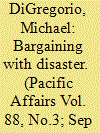

|
|
|
|
|
| Summary/Abstract |
This article uses a problem-driven political economy approach to analyze Quy Nhon City’s ongoing attempts to pursue long-standing urban growth ambitions in the face of increasing awareness of climate threats. In spite of a recent history of multiple, catastrophic floods, the provincial Department of Construction (DOC) has proposed expanding the city’s boundaries into low-lying agricultural areas nearby. Based on past experience and projections of future climate change impacts, environmentalists in the provincial administration have opposed this move. Fuelling this conflict are incentives within Vietnam’s urban development and management system. Rather than respond to urban growth, these incentives are used to lead it. Thus, while climate vulnerability assessments have alerted city and provincial officials to potential dangers in their urban development strategy, incentives within the political-administrative system continue to pull them along a growth pathway that is likely to increase their vulnerability to climate change. Monumental public works and citywide early warning systems mask increasing risks embedded in these urban growth priorities rather than resolve them. Getting the incentives right, therefore, becomes the key to improving resilience to climate change.
|
|
|
|
|
|
|
|
|
|
|
|
|
|
|
|
| 2 |
ID:
140389
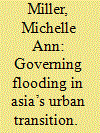

|
|
|
|
|
| Summary/Abstract |
The 21st Century not only marks the advent of Asia’s first urban era in which more than half of its population lives in cities; it is also seeing the emergence of an age of increasing frequency and intensity of environmental disasters. Urban flooding leads disaster trends and is directly impacting the lives and livelihoods of shares of Asia’s population. By 2010 more than 1.5 billion people were residing in urban areas in Asia, accounting for over half of the global urban population. The pervasive coastal and riparian orientation of Asia’s rapid urban transition is placing greater numbers of people in locations that are highly exposed to floods, cyclones, tropical storms and tsunamis. Human transformations of the natural and built environment of cities substantially add to global climate change as interactive sources of the heightening occurrence of floods. Moreover, floods contribute to compound disasters that generate cascading effects with multiple sources, interactive impacts and long-term social and economic recovery issues. The pervasive and socially uneven impacts of floods bring acute awareness of flooding as a political issue for participatory governance. In light of these interwoven complexities, responses can no longer be carried out as sector management tasks, but must instead adopt multi-sector, multi-disciplinary and multi-stakeholder approaches to disaster governance to directly link knowledge to action in preparing for, responding to and recovering from floods in urbanizing Asia
|
|
|
|
|
|
|
|
|
|
|
|
|
|
|
|
| 3 |
ID:
140391


|
|
|
|
|
| Summary/Abstract |
Informal sector actors played a key role in Mumbai’s resilience to disastrous floods in 2005. Members of small-scale retail and service sector businesses, the city’s underclass, its waste workers and scrap dealers and sundry individual tradespersons such as electricians, plumbers, masons and sanitary workers were at the heart of recovery and rehabilitation in the weeks following the floods of July 2005. These floods not only affected significant parts of the city’s new Central Business District (CBD) and business sectors but also its poor and marginalized communities that lived in environmentally fragile and marginal locations. Ironically, these actors have also been at the receiving end of distorted urban planning initiatives, real estate growth, bourgeois environmentalism-inspired middle-class activism and ethnic chauvinist political forces which have pushed them to the city’s social, economic, and spatial margins. Hence, the aforementioned reasons have made the lives and livelihoods of these actors quite precarious and insecure. Going with recent sociological attempts to bridge the expanding field of disaster studies and classical sociological theorization by linking development theories to the study of disasters and their social implications, this paper argues for more imaginative disaster mitigation and management strategies that recognize the role of informal sector workers in post-disaster resilience. It is argued that this recognition should be accompanied by formal state sponsored institutional inclusion and integration of informal sector workers and actors in disaster governance. In Mumbai, informal economic actors were characterized by resourcefulness, access to key networks in enabling recovery, flexibility and innovativeness in design and planning, and the ability to offer low-cost options which could be rapidly deployed. These tend to contrast with the slowness and cumbersome procedures and responses that typify formal state and private responses to disasters. Given the feeble response mechanisms of state institutions in disaster management and mitigation in much of the developing world, and the established fact of citizen action being the first to respond to disaster situations, this paper suggests that paying attention to and involving informal sector actors in disaster governance can both augment the quality of disaster management and enhance the possibility of greater integration of the city’s marginalized and excluded groups into its mainstream social fabric.
|
|
|
|
|
|
|
|
|
|
|
|
|
|
|
|
| 4 |
ID:
140395
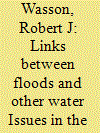

|
|
|
|
|
| Summary/Abstract |
The Himalayan and Tibetan region and adjacent plains are highly flood-prone, causing massive damage in both urban and rural areas. While this is well known and moderately well studied, we contend that floods are connected to other water issues in this region and hence should not be analyzed in isolation. This contention is the major and new contribution of this paper which we analyze using cause–effect diagrams that express dynamic hypotheses. The links emphasize a need to take a much broader than usual view to minimize the unintended consequences of governance interventions, and to avoid worsening already highly dangerous situations. The governance challenges revealed by such a view are immense, but the large-scale framework presented here indicates a need for a collaborative, cross-sectoral approach to adaptive governance. While some of what is suggested in this paper is geopolitically unrealizable at the moment, the discussion is intended as a contribution to efforts to prepare for the changes that are anticipated.
|
|
|
|
|
|
|
|
|
|
|
|
|
|
|
|
| 5 |
ID:
140393
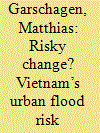

|
|
|
|
|
| Summary/Abstract |
Vietnam’s cities are not only rapidly transforming along with the country’s politico-economic change but are also recognized as being increasingly exposed to natural hazards and the projected impacts of climate change. Resulting are substantial challenges for urban disaster risk governance which, however, remain poorly understood scientifically and underemphasized politically. Against this background, the paper traces the dynamics in urban vulnerability and explores how the responsibilities and capacities for risk reduction and adaptation are issue_image_88_3_Garschagen2negotiated and shared within the country’s changing political economy. Can Tho City, the demographic and economic centre of the highly flood- and typhoon-prone Mekong Delta, serves as an in-depth case study, drawing on 12 months of empirical research. The findings suggest that the transformation process has not only been yielding ambiguous and socially stratified vulnerability effects amongst urban residents; it has also resulted in significant shifts in the way risk management is framed and attributed. Despite the continued paternalistic rhetoric of the party–state apparatus as care-taker, considerable mismatches between state and non-state adaptation action have been found, potentially undermining the effectiveness of both realms. The findings therefore call for a paradigm shift in Vietnam’s urban disaster risk governance. Future approaches need to go beyond the adjustment of physical infrastructure. Rather, the institutional configuration of risk governance itself needs to be adapted in order to mediate and integrate different types of risk reduction measures. These unfold across the increasingly divergent range of urban actors and their interests in terms of spatial scales, temporal scales, normative motivations and capacities.
|
|
|
|
|
|
|
|
|
|
|
|
|
|
|
|
| 6 |
ID:
140394
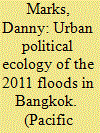

|
|
|
|
|
| Summary/Abstract |
This paper uses an urban political ecology analysis to question the discourses used by Thai government leaders about the causes of the 2011 floods in Bangkok and the solutions that they have proposed in response. In contrast to their argument that the main causes of the floods in Bangkok were climate change and nature, it argues that the causes of the 2011 are compound. They are a result of human-nature interactions: while Thailand did receive heavy rainfall that year, a number of human activities interacted with this heavy rainfall to create the floods. During the past few decades, local political elite have risen to power and profited the most from Bangkok’s urbanization activities while changes to the physical environment of Bangkok made those living there more vulnerable to floods. These activities include massive land use change and concretization which drastically increased run-off, over-pumping of groundwater and the filling of canals. During the past few decades, the local political elite profited the most from Bangkok’s industrialization and urbanization activities while changes to the physical environment of Bangkok made those living there more vulnerable to floods. Further, both the local and national’s government overreliance on antiquated and poorly-maintained infrastructure made the city more vulnerable to the 2011 floods. In 2011, human decisions, particularly by politicians, about where to direct and block water heavily influenced which groups were most vulnerable. As a result, the inner city were protected at the expense of those living in the city’s peripheral areas. Further, the low institutional capacity of the state, at both the local and national level, diminished the state’s capacity to reduce the risks of floods. Analyses of disasters in urban areas need therefore need to consider how discourses, socio-political relations, and ecological conditions shape governance practices of disasters.
|
|
|
|
|
|
|
|
|
|
|
|
|
|
|
|
| 7 |
ID:
140390
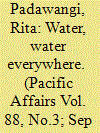

|
|
|
|
|
| Summary/Abstract |
Jakarta has entered an era of chronic flooding that is annually affecting tens of thousands of people, most of whom are crowded into low-income neighbourhoods in flood-prone areas of the city. As the greater Jakarta mega-urban region—Jabodetabek—approaches the 30 million population mark and the sources of flooding become ever more complex through combinations of global climate change and human transformations of the urban landscape, government responses to flooding pursued primarily through canal improvements fall further behind rising flood risks. Years of field observation, archival and ethnographic research are brought together in a political ecology framework to answer key questions concerning how government responses to flooding continue without significant participation of affected residents who are being compelled to relocate when floods occur. issue_image_88_3_PadawangiHow do urban development processes in Jakarta contribute to chronic flooding? How does flooding arise from and further generate compound disasters that cascade through Jakarta’s expanding mega-urban region? What is the potential for neighbourhoods and communities to collaboratively respond through socially and environmentally meaningful initiatives and activities to address chronic flooding? Floods, urban land use changes, spatial marginalization and community mobilization open new political dynamics and possibilities for addressing floods in ways that also assist neighbourhoods to gain resilience. The urgency of floods as problems to be solved is often interpreted as a need for immediate solutions, but flood-resilient communities are rooted in gains in resilience in non-emergency times by expanding rights to live in the city, to build houses and create vernacular communities by and for people
|
|
|
|
|
|
|
|
|
|
|
|
|
|
|
|
|
|
|
|
|